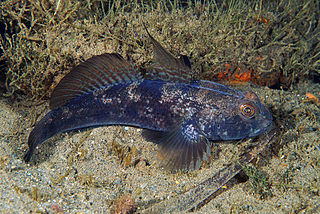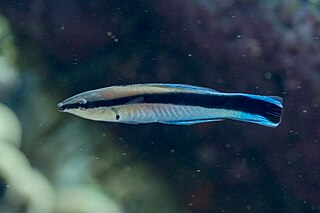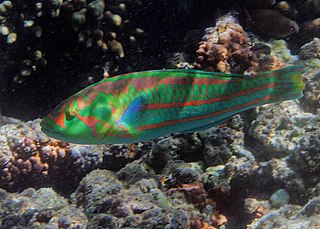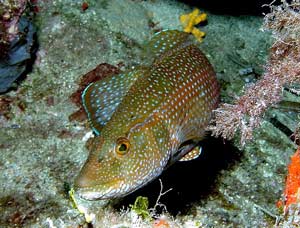
Gobiidae or gobies is a family of bony fish in the order Gobiiformes, one of the largest fish families comprising more than 2,000 species in more than 200 genera. Most of gobiid fish are relatively small, typically less than 10 cm (3.9 in) in length, and the family includes some of the smallest vertebrates in the world, such as Trimmatom nanus and Pandaka pygmaea, Trimmatom nanus are under 1 cm long when fully grown, then Pandaka pygmaea standard length are 9 mm (0.35 in), maximum known standard length are 11 mm (0.43 in). Some large gobies can reach over 30 cm (0.98 ft) in length, but that is exceptional. Generally, they are benthic or bottom-dwellers. Although few are important as food fish for humans, they are of great significance as prey species for other commercially important fish such as cod, haddock, sea bass and flatfish. Several gobiids are also of interest as aquarium fish, such as the dartfish of the genus Ptereleotris. Phylogenetic relationships of gobiids have been studied using molecular data.

Thalassoma bifasciatum, the bluehead, bluehead wrasse or blue-headed wrasse, is a species of marine ray-finned fish, a wrasse from the family Labridae. It is native to the coral reefs of the tropical waters of the western Atlantic Ocean. Individuals are small and rarely live longer than two years. They form large schools over the reef and are important cleaner fish in the reefs they inhabit.

The tomato clownfish is a species of marine fish in the family Pomacentridae, the clownfishes and damselfishes. It is native to the waters of the Western Pacific, from the Japan to Indonesia. Other common names include blackback anemonefish, bridled anemonefish, fire clown, and red tomato clown.

The royal gramma, also known as the fairy basslet, is a species of fish in the family Grammatidae native to reef environments of the tropical western Atlantic Ocean. They are commonly kept in aquariums.

The yellow clown goby, Gobiodon okinawae, also known as the Okinawa goby or yellow coral goby, is a member of the goby family native to the western Pacific from southern Japan to the southern reaches of the Great Barrier Reef. As the name implies, they are bright yellow in color, save for a whitish patch on each cheek.

The moon wrasse also known as the crescent wrasse or lyretail wrasse, is a species of wrasse native to the Indian Ocean and the western Pacific Ocean. It is an inhabitant of coral reefs and surrounding areas at depths from 1 to 20 m. Moon wrasses are carnivorous and tend to prey on fish eggs and small sea-floor dwelling invertebrates. This species can reach 45 cm (18 in) in total length. It is of minor importance to local commercial fisheries and can also be found in the aquarium trade.

The slippery dick is a species of wrasse native to shallow, tropical waters of the western Atlantic Ocean.

Neolamprologus multifasciatus is one of the small shell-dwelling cichlids endemic to Lake Tanganyika. The male reaches 5 cm (2 in) in length, and the female only 2.5 cm (1 in) in the aquarium. In the wild, they reach only 3 centimetres (1.2 in) in standard length of male and female reaches less than 2.2 centimetres (0.87 in) in standard length. This makes them one of the smallest cichlid species in the world. Its natural habitat is the Neothauma shell beds of Lake Tanganyika, where it forms huge colonies with thousands of individuals. Their unique behavior is associated with their affinity to shells. They burrow sand to move shells, take refuge in shells and also breed in them. They have pale white coloring with black vertical bars running the length of their bodies. The species is sexually monomorphic, meaning sexing individuals is extremely hard or impossible based on external appearance alone.

The bluestreak cleaner wrasse is one of several species of cleaner wrasses found on coral reefs from Eastern Africa and the Red Sea to French Polynesia. Like other cleaner wrasses, it eats parasites and dead tissue off larger fishes' skin in a mutualistic relationship that provides food and protection for the wrasse, and considerable health benefits for the other fishes.

Elacatinus is a genus of small marine gobies, often known collectively as the neon gobies. Although only one species, E. oceanops, is technically the "neon goby", because of their similar appearance, other members of the genus are generally labeled neon gobies, as well. Except for a single East Pacific species, all reside in warmer parts of the West Atlantic, including the Caribbean and Gulf of Mexico. They are known for engaging in symbiosis with other marine creatures by providing them cleaning service that consists of getting rid of ectoparasites on their bodies. In return, Elacatinus species obtain their primary source of food, ectoparasites.

Paracentropyge multifasciata, the barred angelfish, banded pygmy-angelfish, many-banded angelfish, multi-banded angelfish or multibarred angelfish, is a species of marine ray-finned fish, a marine angelfish, belonging to the family Pomacanthidae. It is native to the Indo-Pacific.

Elacatinus puncticulatus is a species of goby from the eastern central Pacific Ocean, where it is found on reefs from the Gulf of California to Ecuador. This species occurs at depths ranging from 1 to 21m, and usually in association with the sea urchin Eucidaris thouarsii. The size of the goby varies depending on sex, with females being typically smaller than males, and their geographical location as well as their role as a cleaner goby also has impacts on their morphology. Due to their bright coloration and lack of aggression, the species is commonly found in the aquarium trade.

The queen coris, also known as the sand wrasse, Queen coris wrasse, Formosan coris, Formosa coris wrasse, Formosa wrasse, Indian Ocean wrasse or Indian sand wrasse, is a species of wrasse native to the Indian Ocean from the Red Sea and the coast of east Africa to Sri Lanka. This species appears in the aquarium trade due to its vibrant colors. A special feature about this species is how much they change from juvenile to adult form, in color, behaviour, and diet.

The violet goby is a species of goby native to marine, fresh and brackish waters near the Atlantic coast of North and South America from South Carolina in the United States of America, to northern Brazil. It prefers bays, estuaries and river mouths with muddy substrates. It is often marketed as the dragon goby or dragon fish.

The surge wrasse, also known as the green-blocked wrasse, purple wrasse or red and green wrasse, is a species of wrasse native to the southeast Atlantic Ocean through the Indian and Pacific Oceans, where it inhabits reefs and rocky coastlines in areas of heavy wave action at depths from the surface to 10 m (33 ft). This species is of minor importance to local commercial fisheries, is popular as a game fish, and can be found in the aquarium trade.

Gobiodon histrio, the Broad-barred goby, is a species of goby native to the Indian Ocean from the Red Sea to the western Pacific Ocean to southern Japan, Samoa and the Great Barrier Reef. This species is a reef dweller, being found at depths of from 2 to 15 metres. It can reach a length of 3.5 centimetres (1.4 in) TL. This species can also be found in the aquarium trade.

The honeycomb grouper, also known as black-spotted rock-cod, common birdwire rockcod, dwarf spotted rockcod, dwarf-spotted grouper, honeycomb cod, wire-netted reefcod or wire-netting cod, is a species of marine ray-finned fish, a grouper from the subfamily Epinephelinae which is part of the family Serranidae, which also includes the anthias and sea basses. It has a wide Indo-Pacific distribution where it is found in coastal and offshore reefs in shallow waters.

Labrus viridis is a species of wrasse native to the eastern Atlantic Ocean from Portugal to Morocco, as well as through the Mediterranean Sea to the Black Sea. This species is found around rocky reefs amongst the rocks or in eelgrass beds. It can reach 47 cm (19 in) in standard length, though most do not exceed 37.5 cm (15 in). It is one of several species called green wrasse.

Rhinogobiops is a genus of true gobies in the family Gobiidae. It is monotypic, being represented by the single species, Rhinogobiops nicholsii, also known as the blackeye goby, bluespot goby, and crested goby. They are common inhabitants of coral reefs and rocky habitats along the eastern Pacific Ocean coasts of Mexico, the United States, and Canada, although they are hardly noticed, as they often rest motionless near their shelters.

The yellowhead wrasse is a fish species belonging to wrasse family native to shallow tropical waters in the Caribbean Sea and western Atlantic Ocean.





















